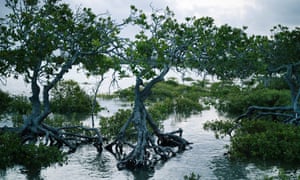Australia’s mangroves and seagrass meadows absorb 20m tonnes of CO2 a
year but report warns damage to ecosystems contributing to climate
change
Australia’s mangroves, tidal marshes and seagrass meadows are
absorbing about 20m tonnes of carbon dioxide every year, according to a
major new study that is the first to measure in detail the climate
benefits of the coastal ecosystems.
But the study, published in the journal Nature Communications, warns that degradation of these “vegetated coastal ecosystems” was already seeing 3 million tonnes of CO2 per year being released back into the atmosphere.
The study reveals Australia’s vast coastlines represent between 5% and 11% of all the so called “blue carbon” locked up in mangroves, seagrasses and tidal marshes globally.
But the study, published in the journal Nature Communications, warns that degradation of these “vegetated coastal ecosystems” was already seeing 3 million tonnes of CO2 per year being released back into the atmosphere.
The study reveals Australia’s vast coastlines represent between 5% and 11% of all the so called “blue carbon” locked up in mangroves, seagrasses and tidal marshes globally.
Some 44 scientists from 33 different research institutions collaborated on the study, which began in 2014.
Dr Oscar Serrano, at Edith Cowan University’s Centre for Marine Ecosystems Research, said it found the coastal ecosystems stored between 4,000m tonnes and 6,300m tonnes of CO2. Australia’s annual emissions hit a record high in 2018 of 558.4m tonnes of carbon dioxide equivalent.
Serrano said: “When these ecosystems are damaged by storms, heatwaves, dredging or other human development, the carbon dioxide stored in their biomass and soils beneath them can make its way back into the environment, contributing to climate change.
“Globally, vegetated coastal ecosystems are being lost twice as fast as tropical rainforests despite covering a fraction of the area.”
Coastal ecosystems store carbon in their soils as well as in the plants themselves and, once absorbed, the carbon can be locked away for thousands of years if undisturbed. They are able to absorb at up to 40 times faster than forests.
“They also protect the coasts from erosion, are important nurseries for fisheries and they clear up the water so it’s very important for several reasons that we preserve these ecosystems,” Serrano said.
He said the ecosystems were being impacted by coastal developments, dredging and by climate change.
The annual losses of carbon from the coastal ecosystems was the equivalent of a 12% to 21% increase in Australia’s land-use emissions from activities such as land-clearing.
In 2015, mangroves on the Gulf of Carpentaria suffered an unprecedented mass dieback along a 1,000-kilometre stretch of coastline that coincided with a major heatwave.
Prof Norman Duke, of James Cook University, who was not part of the study, said the advantage of quantifying the carbon stored in mangroves was that it created a “marketable commodity” that could be used as part of carbon trading schemes.
Duke, who is leading a project to assess the mass dieback event, said mangroves were a particularly powerful tool to cut emissions because they had about five times more capacity to store carbon than trees on the land.
He said: “Because we’re trying to reduce the release of carbon into the atmosphere, this gives us a very strong incentive [to protect them]. But that’s not the only benefits that mangroves deliver – they give habitats to fisheries and protect our coastlines.”
Recovery of mangroves in the gulf has been hampered by dead mangroves, broken up by subsequent storms, piling up on areas of new growth. A seperate study has found the Gulf of Carpentaria’s dead mangroves emit eight times the amount of powerful greenhouse gas methane than live mangroves.
Dr Andy Steven, coasts research director at CSIRO and a co-author of the research, said: “When we started this work in 2014, we had no real numbers. We didn’t know how significant it was, or even if they were worth thinking about. But we’ve shown demonstrably that these ecosystems are very significant.”
To calculate the carbon content of the ecosystems, the researchers combined satellite data on the extent of mangroves and tidal marshes with direct measurements of the carbon stored in soils and plants.
Serrano and Stevens said there was hope the methodology used to calculate the climate benefits of vegetated coastal ecosystems would be used as part of Australia’s official national greenhouse accounts in the future.
Serrano said the research could position Australia as a “world leader” in protecting blue carbon ecosystems, adding other countries could use their work to make their own national measurements.

No comments:
Post a Comment